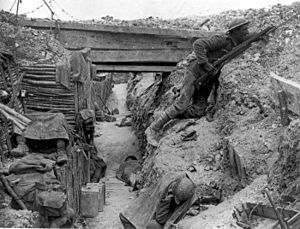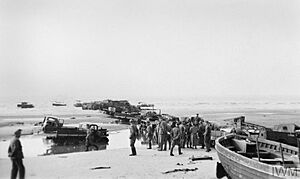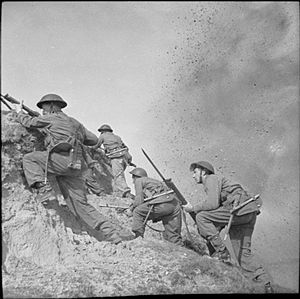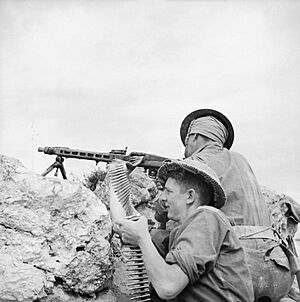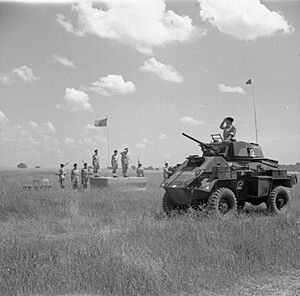History of the British 1st Division during the World Wars facts for kids
Quick facts for kids
|
|
|---|---|

Divisional insignia during the Second World War.
|
|
| Active | 1809 – present |
| Country | |
| Branch | |
| Anniversaries | Peninsular Day |
| Engagements | |
| Insignia | |
| Identification symbol |
|
The 1st Division was a special group of soldiers in the British Army. It was an infantry division, meaning its main job was fighting on foot. This division was created and then put away many times, starting in 1809 and continuing to the present day.
It was first put together by Lieutenant-General Arthur Wellesley, who later became the Duke of Wellington. This was for a war called the Peninsular War, which was part of the Napoleonic Wars. After that war, the division was stopped in 1814. But it was quickly reformed the next year to fight in the War of the Seventh Coalition. It famously fought at the Battle of Waterloo.
The 1st Division stayed active in France until 1818, then it was disbanded again. It was later brought back for other wars, like the Crimean War, the Anglo-Zulu War, and the Second Boer War. In 1902, it was reformed in the UK. This time, it became a permanent part of the army, not just a temporary group for a crisis.
In 1914, the First World War began. The division fought on the Western Front for the entire war. After the war, in 1919, it helped form the British Army of the Rhine, which was an occupation force in Germany. The 1st Division was reformed again in the UK a few months later. Between the big wars, it sent troops to help in the Irish War of Independence, to Constantinople, to oversee a vote in the Saar region, and to serve during the Arab revolt in Palestine.
In the Second World War, the division fought in the Battle of France. Its soldiers were evacuated from Dunkirk in 1940. Later, it fought in the Tunisian and Italian campaigns. It ended the war in the Middle East. During the Cold War, the division was stationed in different parts of Africa and the Middle East before returning to the UK. It was then disbanded and reformed in Germany. In the 1970s, it became the 1st Armoured Division. This division later fought in the Gulf War, served in Bosnia, and took part in the Iraq War. In 2014, it was renamed the 1st (United Kingdom) Division.
Contents
Early History of the 1st Division
The 1st Division was officially created on 18 June 1809. This happened during the Peninsular War in Spain and Portugal. Arthur Wellesley, who led the British forces, formed it. After that war ended, the division was broken up. But it was quickly reformed the next year for the War of the Seventh Coalition.
This division then fought in important battles like Quatre Bras and Waterloo. When the Napoleonic Wars finished, the division stayed in France as part of the Army of Occupation. It was finally disbanded in December 1818 when the British troops left France.
Through the 1800s, the division was brought back three more times. It served in the Crimean War, the Anglo-Zulu War, and the Second Boer War. After the Second Boer War, the British military learned important lessons. Because of this, the 1st Division became a permanent part of the army in 1902. This meant it didn't have to be formed only when there was a crisis or war.
More changes happened in 1907 with the Haldane Reforms. The division became part of Aldershot Command. It also got its own artillery, signals, and Royal Engineers units permanently. The division grew from two to three brigades. These were the 1st Brigade at Aldershot, the 2nd Brigade at Blackdown, and the 3rd Brigade at Bordon. The division also took part in large army training exercises in 1912 and 1913.
The 1st Division in World War I
The 1st Division was a regular army division that was always ready. It was one of the first British divisions sent to France when the First World War started in 1914. It fought on the Western Front for the entire war.
On 31 October 1914, the division's commander, General Samuel Lomax, was badly hurt by a shell. He died on 10 April 1915, never getting better from his injuries. The division's special symbol was the signal flag for 'Number 1'. During the war, the 1st Division fought in many major battles. These included the Battle of Mons, First Battle of the Marne, First Battle of the Aisne, and First Battle of Ypres. It also fought in the Battle of Aubers Ridge, Battle of Loos, Battle of the Somme, Battle of Pozières, Third Battle of Ypres, and Battle of Épehy. Sadly, 16,000 soldiers from the division were killed during the war.
Between the World Wars
After the Armistice of 11 November 1918 ended the First World War, the Allied countries decided to occupy the Rhineland in Germany. This was to make sure Germany paid for the war damages. On 18 November, the 1st Division began its journey to Germany. It crossed the border on 16 December and reached the Bonn area by 24 December.
In January 1919, this occupation force became the British Army of the Rhine. Soldiers who had fought in the war began to go home. About 1,200 men left each day, and this number grew to 2,400 by the end of the month. Younger soldiers replaced them. In March, the 1st Division was renamed the Western Division and stopped existing under its old name.
However, the 1st Division was reformed at Aldershot on 4 June 1919. It became the only British army group based in the UK that was kept ready for emergencies. It sent soldiers to help the British Army in Ireland during the Irish War of Independence. Later, it also helped with the occupation of Constantinople.
The division also started its yearly training again. In 1924, it held its first big exercise since 1913. This training took place between August and September. The brigades trained around Aldershot, and then the whole division trained in the New Forest. On 10 June 1925, George V, the King, reviewed the division. A memorial for the division's fallen soldiers was unveiled by Marshal of France Ferdinand Foch in France on 16 April 1927. This spot was chosen to remember battles the division fought in August 1914 and November 1918.
In December 1934, engineers and signal soldiers from the division went to the Territory of the Saar Basin. They helped international supervisors watch over a vote there in 1935. In July 1935, the King saw the division again during a military review. The next year, in September, the division went to Mandatory Palestine. This was to make the British presence stronger during the start of the Arab Revolt. The 1st and 3rd Brigades moved to Jerusalem. The 2nd Brigade went to Sarafand al-Amar to guard the southern coast. By December, all but the 2nd Brigade returned to the UK. The 2nd Brigade left Palestine in late 1937 and rejoined the division by December.
During 1937, the division became more modern and was reorganized. Each brigade had its number of battalions reduced from four to three. Anti-tank companies were added, and the division got Universal Carriers and more transport vehicles. This made the infantry soldiers much more mobile. In September, army training exercises were held in East Anglia to test these changes. The 1st Division pretended to be rebels who had taken over London (represented by Norwich). Then, forces loyal to the government, played by the 2nd Division, attacked them.
On 14 February 1938, Major-General Harold Alexander took command of the division. He would lead them into the early parts of the Second World War. In the late 1930s, tensions grew between Germany and the UK and its allies. War was avoided in 1938 with the Munich Agreement. But relations quickly got worse. In March 1939, Germany took over parts of Czechoslovakia, breaking the agreement. In May, Alexander joined other high-ranking British officers in France. They talked with their French counterparts about war plans. They also toured the Maginot Line. The division continued training throughout the year. Its final exercise was from 28 to 30 August. When the war began, the division was known as the 1st Infantry Division. It included the 1st Infantry Brigade (Guards), and the 2nd and 3rd Infantry Brigades.
The 1st Division in World War II
Battle of France and Dunkirk Evacuation
The UK declared war on Germany on 3 September 1939, after Germany invaded Poland. The 1st Infantry Division landed in France on 20 September 1939. It reached the border between France and Belgium on 3 October. Along with three other divisions of the BEF, it was based east of Lille. For the rest of 1939 and into 1940, the soldiers trained and built defenses. A historian named David Fraser said that the BEF's regular divisions were good with small weapons. However, they weren't very good at tactics. Even though they could move quickly, they didn't have enough special weapons, ammunition, spare parts, or communication gear. This was because of budget cuts between the wars.
On 10 May 1940, Germany invaded Belgium. In response, the British and French armies moved into Belgium. This was part of the Allied Dyle Plan. The 1st Division reached the River Dyle without problems. It had a tactical success on 15 May. But bigger war events forced the BEF to pull back the next day towards the Escaut River. The 3rd Infantry Brigade acted as a rearguard (a group protecting the main force from behind). It was attacked on 18 May and almost cut off. But it managed to escape with help from the division's artillery. A few days later, the division fought off an attack on its position at the Escaut. The British official history claimed that the Germans attacked using soldiers dressed as civilians or British officers.
On 23 May, the division pulled back again to defend the western bank of the Lys River. Three days later, most of the BEF was trapped in a shrinking area on the French coast. They couldn't hold their position. So, the decision was made to evacuate from Dunkirk. This was the only port still controlled by the British. By the end of May, three of the division's battalions were sent to help the 5th Infantry Division. The main part of the 1st Infantry Division pulled back into the Dunkirk perimeter. The division's engineers built a temporary pier out of lorries at Bray-Dunes. This pier became very important when small ships arrived to help with the evacuation.
Meanwhile, the division's infantry, along with the 46th Infantry Division, defended the Canal de Bergues between Bergues and Hoymille. On 31 May and 1 June, they were heavily attacked. Some positions were held, but others were broken through. The troops were forced back to the Canal des Chats. During this fighting, Captain Marcus Ervine-Andrews earned the Victoria Cross for his bravery. By the end of the next day, the division had been evacuated back to the UK. The 1st Battalion, King's Shropshire Light Infantry, was the division's rearguard. They left via the Dunkirk mole on the ferry St Helier, just before midnight. They were among the last British soldiers to leave Dunkirk. Over 30,000 French soldiers stayed behind in the heavily damaged town to cover the final British withdrawal.
Home Defence and Reorganization
Once back in the UK, the division moved to Lincolnshire to defend the coast. It partly replaced the 2nd Armoured Division and the 66th Infantry Division. It stayed there through 1941. During this time, it moved further inland to be a reserve force. The Lincolnshire County Division took over coastal defense. Since its return from France, the division was seen as one of the best-equipped and trained groups in the UK. It was kept in reserve to be sent quickly to southern England if Germany invaded. During this period, the Guards Brigade was replaced by the 38th (Irish) Infantry Brigade.
In 1942, the division moved to East Anglia. In June, it was reorganized as a "mixed division." This new idea meant an infantry division would have one infantry brigade removed and replaced by a brigade of tanks. Before this, British tank brigades were separate groups. They were given to other commands as needed. This change was meant to bring armored forces more into the main army. In June, the 34th Tank Brigade joined the division. The Irish brigade left in early July to fit the new organization. Even though there were training plans for infantry and tanks to work together, training between them didn't start until August. The next month, the 34th Tank Brigade was replaced by the 25th Tank Brigade.
The "mixed division" idea didn't work well because it left the division with too few infantry soldiers. So, in November, it went back to being an infantry division. The 25th Tank Brigade left, and the 24th Infantry Brigade (Guards) replaced them. In 1943, the division joined the new First Army. It left the UK on 28 February, heading for North Africa.
Tunisian Campaign
The 1st Division arrived in North Africa on 9 March 1943. It moved to the Medjez-Bou Arada area of Tunisia. It joined the ongoing Tunisian campaign and carried out patrols in the following weeks. On 4 April, it was temporarily renamed the 1st British Infantry Division. This was to avoid confusion with the US 1st Infantry Division, which was also fighting there.
German General Generaloberst Hans-Jürgen von Arnim knew the Allied forces were planning a big attack. To try and delay them, he approved an attack by German divisions. These included the Division Hermann Göring and the 334th Infantry Division, supported by 10th Panzer Division and Tiger I tanks. On 21 April, six German battalions attacked the British 1st and 4th Divisions near Medjez el Bab. The 3rd Brigade, holding a ridge called 'Banana Ridge', took the main force of the attack in the 1st Division's area. The German attack caused a dangerous situation for Allied artillery. But the attack was pushed back, and the 1st Division had only 106 casualties. The British claimed 33 German tanks and 450 prisoners. The next morning, Operation Vulcan began. This was meant to be the final Allied push in Tunisia to capture Tunis.
Two days later, the 1st Division began its part of the operation. With strong artillery support and 45 tanks, the 2nd Brigade attacked a ridge between Grich el Oued and Gueriat el Atach. They had initial success, but couldn't dig in properly. A quick German counterattack pushed them back. Fighting went back and forth all day, and the ridge stayed in German hands. The 2nd Brigade had over 500 casualties. 29 of the supporting tanks were damaged or destroyed. Lieutenant Willward Alexander Sandys-Clarke was given a Victoria Cross after his death for his actions in this fighting.
The next day, 24 April, the 3rd Brigade launched a new attack and captured the ridge. They then faced heavy German bombing and had over 300 casualties. On 27 April, the division's next major attack began. The 24th Infantry Brigade (Guards) attacked Djebel bou Aoukaz, another defended ridge. The first attack almost succeeded but failed. A new effort the next day captured the ridge. But it was lost again after a German counterattack by parts of the 10th Panzer Division. The overall Allied advance had slowed. Operation Vulcan ended about 25 miles (40 km) short of Tunis. However, the division continued fighting back and forth until the ridge was finally secured on 5 May. This fighting caused over 300 casualties in one battalion. Two more Victoria Crosses were earned by members of the division. Capturing Djebel bou Aoukaz secured the side for the new offensive. This new attack started on 6 May and used other forces, not the 1st Division. Tunis was captured the next day. German and Italian forces in North Africa surrendered on 12 May 1943.
Pantelleria Island Capture
Pantelleria is an island between Sicily and Tunisia. The Italians had made it a strong fortress. By 1943, it had 12,000 soldiers, radar sites, and an airbase with underground hangars. After the Axis forces were defeated in North Africa, the Allies decided to capture Pantelleria (Operation Corkscrew) before invading Sicily.
To avoid a bloody attack, which the 1st Infantry Division would have carried out, the island was heavily bombed from the air. From 18 May to 11 June, about 6,400 tons of bombs were dropped. The Italian soldiers on the island didn't know that the ships carrying the 1st Division arrived 8 miles (13 km) offshore on the morning of 11 June. Around the same time, the Italian commanders on the island decided they couldn't hold out and chose to surrender. This happened just as the 1st Division began its landing operations. Under the protection of fighter planes, a final bombing raid, and naval gunfire, the 1st Division landed around noon. They were met by white flags of surrender. The other nearby islands were taken the next day without any fighting. With the islands secured, the division went back to North Africa on 14 June. Four days later, the first Allied planes started flying from the island. They provided air cover during the attack on Sicily. The capture of Pantelleria made Germany send more troops to Sardinia and Sicily. However, the Allies had tricked the Germans into thinking this was just the first step in a series of attacks that would end with an invasion of Greece.
Anzio Landing in Italy
Back in North Africa, the division trained and guarded prisoners of war. This lasted until early December 1943. Then, it moved to Italy and gathered near Cerignola. It was preparing to join the Eighth Army fighting on Italy's east coast. In the months before, Allied forces had landed in southern Italy. They had accepted Italy's surrender and pushed German forces north. The Germans had dug in along the Winter Line, stopping the Allies from capturing Rome.
Since late September, there had been talks about an amphibious landing behind the front lines. But problems with supplies and strategy delayed this until the end of the year. Anzio, south of Rome, was chosen as the landing site. The Fifth Army, fighting on Italy's west coast, had two jobs: advance north through the Winter Line and carry out the landing. The 1st Division was assigned to the Fifth Army for this operation. So, it moved to the Salerno-Naples area in early January and started special training on 14 January 1944. Between 17 and 19 January, a full-scale practice called Exercise Oboe was held in the Bay of Salerno. This was for the 2nd Infantry Brigade, which would land first. Other parts of the division took part on a smaller scale. The day after the exercise, the division joined the US VI Corps, which was in charge of the landing for the Fifth Army.
The first attack was carried out by the 2nd Infantry Brigade. It was strengthened with tanks, reconnaissance troops, artillery, engineers, and more infantry. The rest of the division was kept as a floating reserve, ready to be used anywhere in the landing zone. Just after 2:00 AM on 22 January, the 2nd Brigade landed. They moved inland with little resistance. The rest of the division started landing a few hours later. All were ashore by the end of the next day, still in a reserve role. During the day, the first German counterattacks began. Several infantry companies attacked the 2nd Brigade, but they were pushed back.
On 24 January, the division was no longer in reserve. Its forward patrols reached Aprilia (called 'the factory' by the soldiers) and positions along the Moletta River. This secured the left side of the landing zone. By this time, German troops from Germany, France, Yugoslavia, and other parts of Italy had started to move to stop the landing.
Route 7, a highway, was a very important supply line for German forces at the Winter Line. It passed through Cisterna di Latina. So, this town was a target for the Allies. Carroceto and Aprilia were captured on 25 January. The division worked to help VI Corps achieve this goal. Over the next few days, patrols were sent out, small gains were made, and the division fought off several more German counterattacks. At least one British company was overrun. The first corps-wide attack had failed. But a new effort began on 30 January after enough forces had landed and the corps had secured its supply base.
The division's job was to advance towards Albano Laziale and Genzano di Roma. The goal was to create conditions for the US 1st Armored Division to possibly push towards Rome. The division reached Campoleone but couldn't go further. The US tanks couldn't make an impact because of mud and difficult terrain. The division regrouped to hold the ground it had captured, which was a deep bulge in the German lines. By early February, the Germans had gathered a force almost as strong as the Allies in the beachhead. On the division's front, between 3 and 4 February, German efforts focused on destroying the bulge. Because of the terrain, some of the division's units couldn't set up positions that supported each other. The Germans used this to sneak in between them. Some initial German attacks were fought back. But some British positions were overrun, or the troops were forced to fall back. By the end of 4 February, the German attack had pushed the division back to the positions it held on 30 January. It had caused 1,400 casualties. Further German attacks steadily gained ground. By the end of 10 February, Aprilia and Carroceto had also been lost by the division. It then moved into reserve. During this time, the divisional commander, Major-General Ronald Penney, was wounded and had to be away for several days.
Stalemate at Anzio
There was very heavy fighting over the next few weeks. The Germans launched several fierce counterattacks. They tried to push the Allied forces back into the sea. For example, on 17 February, Penney was wounded by shellfire. Command of the 1st Division was taken by Major General Gerald Templer from 18 to 22 February. Templer was from the recently arrived 56th (London) Infantry Division. Penney then returned to command.
Because of the heavy fighting in February and March, the 24th Infantry Brigade (Guards) was pulled out of the division. This was because there weren't enough Guards replacements. Even at this stage of the war, the Guards were the only infantry regiments in the British Army to get replacements from their own regiment. The 24th Infantry Brigade was replaced by the 18th Infantry Brigade. This brigade was from the 1st Armoured Division, which was in North Africa at the time.
Operation Diadem was the final battle for Monte Cassino. The plan was for the U.S. II Corps on the left to attack up the coast along Route 7 towards Rome. The French Expeditionary Corps (CEF) to their right would attack from the bridgehead across the Garigliano into the Aurunci Mountains. The British XIII Corps in the center right would attack along the Liri valley. On the right, the 2nd Polish Corps would isolate the monastery and push around behind it into the Liri valley to link with XIII Corps. The I Canadian Corps would be held in reserve, ready to use the expected breakthrough. Once the German Tenth Army was defeated, the U.S. VI Corps would break out of the Anzio beachhead. This was to cut off the retreating Germans in the Alban Hills.

As the Canadians and Polish launched their attack on 23 May, Major General Lucian Truscott launched a two-pronged attack. He used five (three American and two British) of the seven divisions in the Anzio beachhead. The German 14th Army facing this attack had no armored divisions. This was because Kesselring had sent his tanks south to help the German 10th Army at Cassino. The 18th Infantry Brigade, which was temporarily with the 1st Division from February to August, returned to the 1st Armoured Division. It was replaced by the 66th Infantry Brigade, which stayed with the 1st Division for the rest of the war.
In the fighting for the Anzio beachhead, 8,868 officers and men of the 1st Infantry Division were killed, wounded, or went missing.
The 1st Division After World War II
After the war, the 1st Division stayed in Palestine for only a short time. It was moved to Egypt for a few months before going back to Palestine in April 1946. Two years later, when the British rule over Palestine ended, the division returned to Egypt. It also spent time in Libya until 1951. In October of that year, as British forces left Egypt outside the Suez Canal Zone, the division was stationed in that area.
After British forces left Egypt, the division returned to the UK for a short time in 1955 and 1956. It remained in the UK until 30 June 1960. Then, it was disbanded because there was no longer a need for another division headquarters in the UK. However, it was reformed the very next day when the 5th Division was renamed. The new division was based in Germany as part of the British Army of the Rhine.
In April 1978, the division was reorganized and renamed the 1st Armoured Division. Under this new name, it fought in the Gulf War in 1990–1991. When the Cold War ended, the British government reorganized the army. This led to the division being disbanded again on 31 December 1992. In 1993, the 4th Armoured Division, based in Germany, was renamed the 1st (United Kingdom) Armoured Division. During the 1990s, the division was sent to Bosnia to help with peacekeeping. In the 2000s, it fought in the Iraq War. In 2014, the division was renamed the 1st (United Kingdom) Division.
See also
- List of commanders of the British 1st Division
- List of wartime orders of battle for the British 1st Division (1809–1945)
- List of Victoria Cross recipients from the British 1st Division
- British Army Order of Battle (September 1939)
- Medjez-El-Bab Memorial
- Tiger 131



